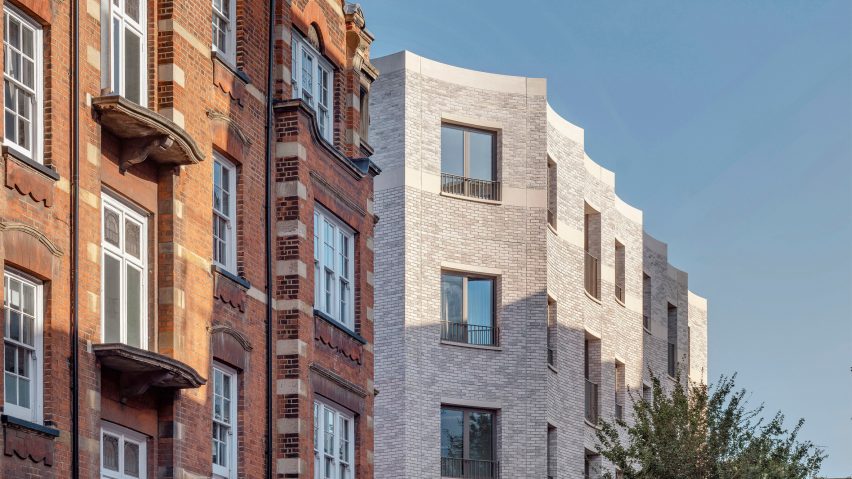Scalloped facades featuring tones of cream and red brick define a U-shaped housing block by Bell Phillips in Marylebone in central London.
Named Cosway Street after the road on which the building sits, the design of the 49-home development in the Lisson Grove Conservation area aims to repair the fragmented streetscape by re-establishing the urban block.
London studio Bell Phillips wanted to create a contextual and contemporary addition to the Georgian and late Victorian architecture that surrounds the site.
"We found inspiration in the particular way that the urban blocks in the area celebrate corners with curved or chamfered bays," studio director Hari Phillips told Dezeen.
"We translated this into a concave inflection at the corners of our building ,which we then extended into a motif that runs along the main facades," he continued.
Bell Phillips was commissioned by Westminster City Council to contribute to the Church Street masterplan, a key regeneration scheme to provide the area with new homes.
The site, which was part of the masterplan's first phase and was allocated for private housing, helped cross-subsidise the delivery of 28 social rent homes on neighbouring sister schemes, according to the council.
The U-shaped, three-sided perimeter block consists of 49 one, two, and three-bedroom apartments across five floors, all arranged around a communal garden inspired by traditional London squares.
The scalloped building is split into three distinct sections, each defined by a brick colour and mortar that responds directly to the character of the building across the street.
The fluted facade motif echoes the circular columns and arched windows of a nearby Grade II* listed church and is repeated at different scales across the building.
"By flexing the rhythm, colour and tone of these fluted bays to match the surrounding buildings we found a language for the new building that is its own whilst very much embedding itself in its setting," said Phillips.
A palette of three bricks in soft hues of cream, buff and red form the tonal palette of the building. Precast concrete sills and lintels were coloured to match the bricks.
"Regardless of the age of buildings, the surrounding context is uniformly brick with details in stone or stucco," explained Phillips.
"With this in mind, brick felt like the natural response, with precast concrete standing in as a contemporary replacement for stucco as a secondary material around windows, along the parapet and to the entrance surrounds," he continued.
The studio designed the building's external walls using precast elements faced with brick, which it said were produced offsite to reduce build time.
"From the outset we were conscious that the fluted brick facade would be challenging to construct in traditional hand-laid brick," explained Phillips.
"The rhythms and proportions of the fluted facade are designed to echo adjacent buildings, [and] these were rationalised into a limited number of repetitive curvatures during the design process to simplify the moulds required," he continued.
Darker mortar was used for the ground floor, which then transitions to a lighter colour for the storeys above.
Inset balconies carved out of the facade were designed to give the block a sculptural quality while adding depth and shadow. The apartments that crown the building have private outdoor terraces that provide views towards central London.
Inside Cosway Street, the apartments have a material palette that reflects the tones and colours of the exterior. Designed by Amos and Amos, the homes have large windows and high ceilings throughout to maximise daylight.
The dual and triple-aspect flats have open-plan living spaces that open out onto the inset balconies, with some homes featuring secondary openings onto the outdoor spaces via a bedroom.
Cosway Street was designed by Bell Phillips up until planning, and delivered post-planning by Osborne Contractors with David Miller Architects.
Bell Phillips was founded by Phillips and Tim Bell in 2004. Previous projects by the studio include mirrored and larch-clad pavilions added to a science and innovation campus in Oxfordshire, and a timber "tree-house" pavilion in Elephant Park in London.
Other multi-unit residential projects in London featured on Dezeen include a mixed-use project combining housing, artist studios and a gallery in Bermondsey by Coffey Architects, and a courtyard housing block of grey brick in Clapham by Sergison Bates Architects.
The photography is by Kilian O'Sullivan.

